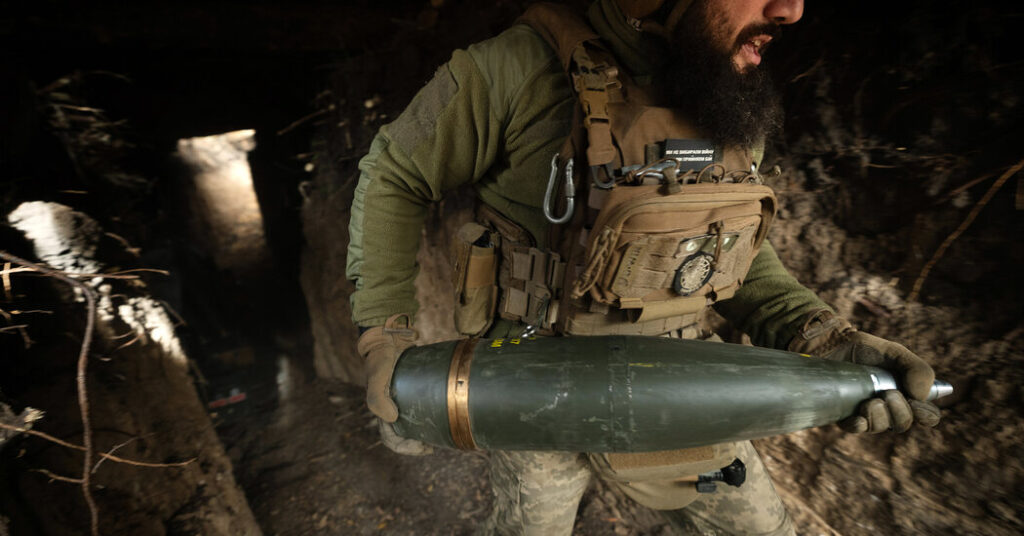President Volodymyr Zelensky of Ukraine, already in a crucible of pressure from a corruption scandal and battlefield setbacks, is now facing one of the deepest quandaries of his presidency in a new peace plan from the United States.
The 28-point proposal favors Russia in pivotal aspects, including requiring Ukraine to cede territory and cap the size of its postwar army, while offering financial and geopolitical incentives to Moscow. Ukraine has rejected many of the conditions before, but Kyiv’s room for maneuver is shrinking as the Trump administration pushes for a response by next week.
Mr. Zelensky referred to the tightening vise in a speech to the nation on Friday. He cast the American proposal as a dilemma between losing the United States as an ally and acquiescing to Russian demands. He seemed to suggest that the United States had threatened to withhold what assistance it still provided, which was mostly limited to intelligence sharing.
“Now is one of the most difficult moments in our history,” Mr. Zelensky said. “Now Ukraine may face a very difficult choice: either loss of dignity or the risk of losing a key partner.” Ukraine would have to accept concessions, he said, or face “an extremely difficult winter, the most difficult, and further risks.”
Mr. Zelensky said of the United States, “They will expect an answer from us.” He said that he would adhere to Ukraine’s constitution and would “offer alternatives,” and that Ukraine should not be cast as shunning diplomacy to end the war.
The Ukrainian leader responded to the increasing pressure by turning, as he has before, to European allies. He held a conference call with President Emmanuel Macron of France, Chancellor Friedrich Merz of Germany and Prime Minister Keir Starmer of Britain. In a statement, Mr. Zelensky said that Ukraine would coordinate its next moves with the European leaders.
How effectively Mr. Zelensky can negotiate with the Trump administration will largely depend on how much continued European support he can muster.
His outreach repeats a playbook that kept him in the game with the Trump administration’s negotiating tactics at earlier moments of tension. When called on, Ukraine’s allies in Europe, alarmed by the potential security threats to their countries of a Russian victory in the war, have provided backup.
European leaders embraced Mr. Zelensky after President Trump lit into him at an Oval Office meeting in February. They negotiated to buy U.S. weapons for Ukraine after the Trump administration closed the spigot of military aid. And European leaders flew to Washington to support Mr. Zelensky after a summit in August between Mr. Trump and President Vladimir V. Putin of Russia, another moment that raised fears that the Trump administration and the Kremlin were moving to impose unfavorable terms on Kyiv.
The 28-point document now being pushed by the White House was negotiated between Steve Witkoff, Mr. Trump’s envoy for peace missions, and a Russian official, Kirill Dmitriev. In a radio interview on Friday, Mr. Trump said that he wanted a response from Mr. Zelensky by Thursday, but that the deadline could be extended “if things are working well.”
Ukraine and Europe have said they had no input in the proposal, and European foreign ministers voiced outrage over the plan, saying it would weaken Ukraine’s long-term security.
According to a draft posted online by a Ukrainian lawmaker, the proposal would require Ukraine to change its constitution to prohibit any effort to join NATO. It would force Kyiv to recognize Russian control of the eastern Donetsk and Luhansk regions, parts of which Ukraine still holds. And it would cap the size of the Ukrainian Army at 600,000, down from an estimated current strength of more than 800,000.
The proposal would also bar the presence of NATO troops inside Ukraine, which would derail a European plan to help ensure the country’s postwar security.
If Ukraine agrees to end the war, the proposal says, it would be given frozen Russian assets to help pay for its reconstruction. Kyiv would also receive what the plan calls reliable security guarantees, promising a military response if Russia invaded again but offering few details.
If Moscow were to invade again, the proposal says, sanctions would be reinstated and Moscow would lose benefits included in the agreement. Those sweeteners include major Russian goals like readmittance to the Group of 8, reintegration into the global economy and joint investment opportunities with the United States.
The proposal comes as Mr. Zelensky’s government has been weakened by a sweeping corruption scandal implicating ministers and associates of the president. They are accused of taking millions of dollars in kickbacks from the state-owned nuclear energy company.
At the same time, Ukraine is under growing pressure on the battlefield. Its army is short of soldiers, leaving gaps on the front line that Russia has exploited for small advances. And Kyiv is facing increasing financial strain, with a European plan to finance next year’s budget through loans linked to frozen Russian funds now in doubt.
There is rising support within Ukraine for a peace deal, after years in which Ukrainians mostly seethed at Russia’s invasion and opposed any concessions. Support for a negotiated settlement has grown from 10 percent in 2022, the first year of the war, to 74 percent today, according to polling by the Kyiv International Institute of Sociology.
In Russia, the government has said little about the 28-point plan. But the Kremlin hardened its tone toward Ukraine on Friday, warning that Kyiv must enter into negotiations “now rather than later” or face losing more territory.
Speaking with journalists, Dmitri S. Peskov, Mr. Putin’s spokesman, said that Mr. Zelensky’s “room for maneuver regarding decision-making is shrinking as territories are lost during the offensive actions” of the Russian Army.
“Continuing is senseless and dangerous for them,” Mr. Peskov added, referring to the Ukrainian leadership.
On Thursday, Mr. Putin took the opportunity to emphasize that Russia was making progress on the battlefield, donning fatigues at a command post. At a security council meeting in the Kremlin on Friday, Mr. Putin said that Russia was ready either to discuss the U.S.-backed plan or continue fighting.
Ukrainian commentators suggested that Russia was pressing the settlement proposal now to exploit Mr. Zelensky’s vulnerability from the corruption accusations and to delay any decision by Europe on the frozen Russian assets.
The talks that led to the 28-point plan are taking place outside traditional channels for both the Americans and the Russians. Diplomatic ties became strained last month when the United States canceled a proposed summit in Hungary between Mr. Trump and Mr. Putin, seeing little sign that Russia was willing to compromise.
In the meantime, Mr. Witkoff, the real estate developer turned top negotiator for Mr. Trump, worked on the 28 points with Mr. Dmitriev, a longtime Putin ally and head of Russia’s sovereign wealth fund.
Mr. Dmitriev’s role in Ukraine talks had originally been limited to negotiating possible U.S.-Russian business and economic deals. Now Mr. Dmitriev appears to have veered into the center of peace negotiations.
The terms of the settlement proposal require many steps beyond Ukraine’s control.
The settlement envisions a halt to NATO expansion, ending a long policy of an open door at the alliance, as well as Russia’s acceptance into the G-8, a club of wealthy democracies, from which it was expelled after annexing the Crimean Peninsula from Ukraine in 2014.
The agreement would require $100 billion in frozen Russian assets to be spent on U.S.-led reconstruction in Ukraine, with half of the profits given to America. A separate fund would be reserved for U.S.-Russian joint ventures.
Ukraine would withdraw from territory it controls in the Donetsk region, including the fortress cities of Sloviansk and Kramatorsk, and the area would become a demilitarized zone.
The proposal would also require amnesties for crimes committed during the war. Ukraine has opened thousands of war crimes investigations, including over well-documented mass killings and torture in occupied areas.
As Mr. Zelensky prepared to negotiate over the plan’s terms, it was unclear whether Russia was willing to do the same.
“If it’s treated as a framework for a negotiation, on which the outcome of these issues is not predetermined, then it could move us in some direction,” said Samuel Charap, a senior political scientist and Russia specialist at the RAND Corporation.
Andrew E. Kramer is the Kyiv bureau chief for The Times, who has been covering the war in Ukraine since 2014.
The post The U.S. Tightens the Vise on an Already Besieged Zelensky appeared first on New York Times.




